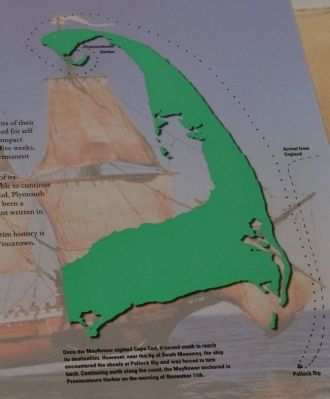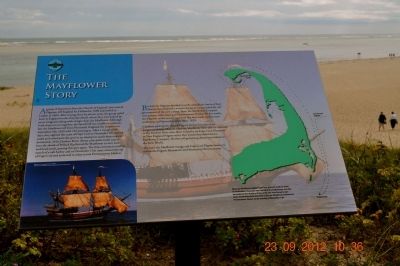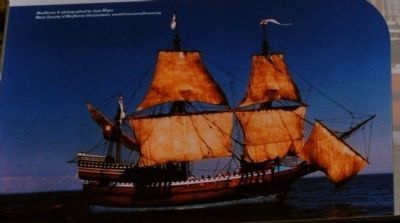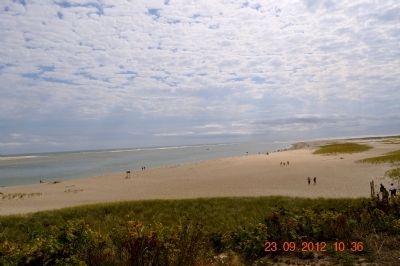Chatham in Barnstable County, Massachusetts — The American Northeast (New England)
The Mayflower Story
Because the Pilgrims decided to settle outside the limits of their charter, they believed a written document was needed for self government of the new colony. Thus, the Mayflower Compact was written. After staying in Provincetown Harbor for five weeks, the Pilgrims sailed across Cape Cod Bay and made a permanent settlement in Plymouth in December, 1620.
Chatham profoundly shaped Pilgrim history because of its dangerous waters offshore. Had the Mayflower been able to continue to the Hudson River area, there would be no Cape Cod, Plymouth or New England Pilgrim story. Nor would there have been a Mayflower Compact, the first self governing document written in the New World.
The story the Mayflower voyage and Cape Cod Pilgrim history is told at the Pilgrim Monument and Museum in Provincetown.
Erected 2012. (Marker Number 8.)
Topics. This historical marker is listed in these topic lists: Exploration • Settlements & Settlers.
Location. 41° 40.267′ N, 69° 56.951′ W. Marker is in Chatham, Massachusetts, in Barnstable County. Marker is on Main Street. This marker is next to the parking lot facing the Atlantic Ocean and across the road from the Chatham Lighthouse. Touch for map. Marker is in this post office area: Chatham MA 02633, United States of America. Touch for directions.
Other nearby markers. At least 8 other markers are within walking distance of this marker. The Rescue of the Pendleton (a few steps from this marker); Original Prop (a few steps from this marker); History of Chatham Lighthouse (within shouting distance of this marker); U.S. Coast Guard Steel 44-Foot Motor Life Boat CG44301 (within shouting distance of this marker); Captain Mayo / Surfman Ellis
(about 300 feet away, measured in a direct line); The Battle of Chatham Harbor (about 300 feet away); Sailors Memorial (about 400 feet away); Chatham Packet Wharf (approx. 0.2 miles away). Touch for a list and map of all markers in Chatham.
Regarding The Mayflower Story. First, the Separatists returned to London to get organized. A prominent merchant agreed to advance the money for their journey. The Virginia Company gave them permission to establish a settlement, or “plantation,” on the East Coast between 38 and 41 degrees north latitude (roughly between the Chesapeake Bay and the mouth of the Hudson River). And the King of England gave them permission to leave the Church of England, “provided they carried themselves peaceably.”
In August 1620, a group of about 40 Saints joined a much larger group of (comparatively) secular colonists–“Strangers,” to the Saints–and set sail from England on two merchant ships: the Mayflower and the Speedwell. The Speedwell began to leak almost immediately, however, and the ships headed back to port. The travelers squeezed themselves and their belongings onto the Mayflower and

Photographed By Sandra Hughes, September 23, 2012
3. The Mayflower Story Marker
Once the Mayflower sighted the Cape Cod, it turned south to reach its destination. However, near the tip of South Monomoy , the ship encountered the shoals at Pollock Rip and was forced to turn back. Continuing north along the coast, the Mayflower anchored in Provincetown Harbor on the morning of November 11th.
Because of the delay caused by the leaky Speedwell, the Mayflower had to cross the Atlantic at the height of storm season. As a result, the journey was horribly unpleasant. Many of the passengers were so seasick they could scarcely get up, and the waves were so rough that one “Stranger” was swept overboard and drowned. (It was “the just hand of God upon him,” Bradford wrote later, for the young sailor had been “a proud and very profane yonge man.”)
Also see . . . The Mayflower -Wikipedia. (Submitted on February 22, 2013, by Bill Pfingsten of Bel Air, Maryland.)
Credits. This page was last revised on June 16, 2016. It was originally submitted on February 18, 2013, by Sandra Hughes Tidwell of Killen, Alabama, USA. This page has been viewed 974 times since then and 27 times this year. Last updated on October 26, 2014, by Byron Hooks of Sandy Springs, Georgia. Photos: 1, 2, 3, 4. submitted on February 18, 2013, by Sandra Hughes Tidwell of Killen, Alabama, USA. • Bill Pfingsten was the editor who published this page.


